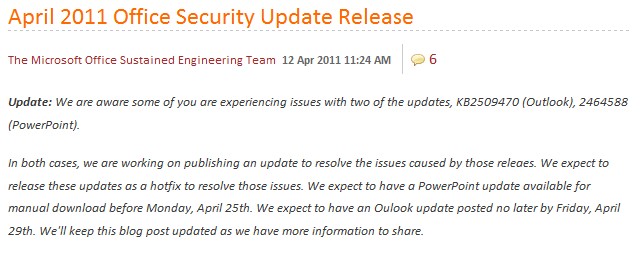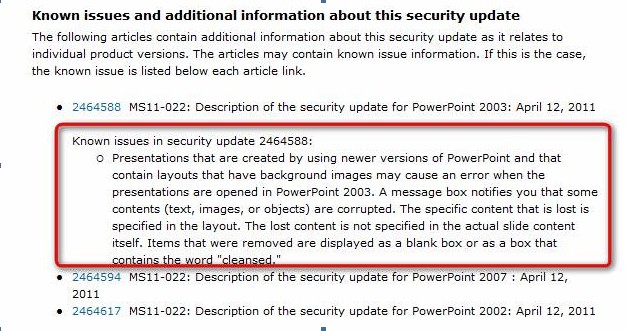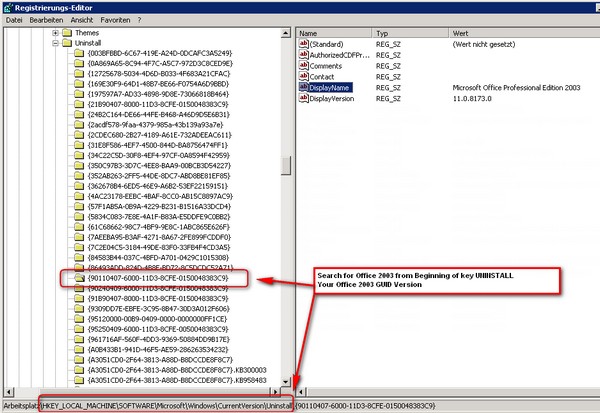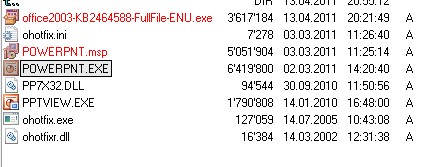Side Effect and Error of Microsoft patch KB 2464588 and Powerpoint 2003
Status 11.05.2011, There is a hotfix coming via WSUS or Windows Update. You may still need manual work PER Powerpoint Master Slide.
Solution 11.05.2011 after Installing this Windows Update (manuall or via WSUS)
http://support.microsoft.com/kb/2535812
If you have a plan that has multiple masters, and you saved the file after you applied update 2464588, the presentation may continue to freeze after you change it.
Note For more information about security update 2464588, see the “Security update replacement information” section.
To correct this behavior, apply this security update. Then, follow these steps:
- Open a new blank presentation.
- On the Insert menu, click Slides from Files.
- Locate and open the problem presentation.
- Select the Keep source formatting option.
- Click Insert all, and then click Close.
- Delete the first empty slide, and then save the new presentation file.
WSUS Problem Patch that causes the effect: MS KB2464588
- File that causes the effect: Office2003-KB2464588-Fullfile.exe
- Release/Install Date 13.04.2011
- Solution: Hotfix 2543241 from Microsoft Release Date 26.04.2011
- http://support.microsoft.com/hotfix/KBHotfix.aspx?kbnum=2543241&kbln=en-us
- Hotfix download direct from our site www.butsch.ch: office2003-KB2543241-ENU.zip (3.35 mb) (contains fixed: POWERPNT.msp)
To silent install the Hotfix 2543241 use any three of these ways:
1 c:\office2003-KB2543241-ENU.exe /C /T:C:\temp /Q
(This is direct without unpacking the MSP from the EXE)
2 c:\windows\system32\msiexec.exe /p “c:\POWERPNT.msp” /qb
(This is with the unpackages MSP-File)
3 %windir%\System32\msiexec.exe /P C:\POWERPNT.msp REBOOT=ReallySuppress /L*V C:\patch.log /QN
(This is with the unpackaged MSP-File and make sure he does not reboot and write a logfile)
Notes on the hotfix KB2543241
- To install the hotfix you need to extract the hotfix with password received in email, then run the office2003-KB2543241-ENU.exe to extract POWERPNT.msp. Then run POWERPNT.msp.
- The hotfix 2543241 includes the security update in 2464588 and fixes the error opening ppt files. So if you have uninstalled 2464588 you can simply install 2543241 and the vulnerabilies in MS11-022 are patched.
- If you already saved files with 2464588 error that removed the “corrupt” content, the hotfix 2543241 will not be able to go back in time and recover that data.
-
Files that were not saved after you opened with 2464588 and got the error (closed without saving) will have the content in-tact without the error.
-
The Powerpnt.exe build for the hotfix 2543241 is 11.8335.xxxx. You can check the file version in %systemdrive%\Program Files\Microsoft Office\Office11, assuming you installed to the default install location for Office 2003. This may come in handy if want to verify you have the hotfix or not.
The hotfix 2543241 applies to all languages. - The hotfix 2543241 is not in Windows Update or WSUS.
- The hotfix 2543241 will be in the June security updates that will be in Windows Updates.
- For the hotfix announcement see http://blogs.technet.com/b/office_sustained_engineering/archive/2011/04/23/issues-after-installing-powerpoint-2003-update-kb2464588.aspx
- If you’re still seeing issues with the hotfix 2543241 installed please contact MS Support – http://support.microsoft.com/select/Default.aspx?target=assistance
What is the Problem: Suddenly folks can’t open any Powerpoint 2003 which where made under Powerpoint 2007/2010. They say it’s corrupt or crash while working after a few minutes. First time a Office patch realy has larger impact and it hits the right ones (The Managers who don’t like IT and it’s cost). Guess Microsoft had no time with the Zero Day Exploit to check all, however it was the right decision from them to release this patch since it fixed the 0day leak.
Manager Reminder: This is why you pay IT pros for taking care of your WSUS Windows Update Server or your small business. A qualified IT-Engineer will Analyse the current patches in your company or external as Conusultant and THEN test the Patches on a range of PC’s. After that, and feedback from other customers, he will aprove the Updates for the rest of the clients. Microsoft can’t know what happens when you use their poatches with your localized software from Australia, USA or India. So that’s why you test. This is clearly a MS Only bug but they made it right in pushing out the patch fast.
This is something you have to PAY for and invest money so your Powerpoint keeps running and your can make money with your business. Windows Update Server is a free Product from Microsoft to take of Patching your IT enviroment.
Instruction for Enduser on how to Deinstall the Microsoft Patch that causes the Problem:
Office 2003 on Windows 7
- START / SETTINGS / CONTROL PANEL / PROGRAMS AND FEATURES
- Select “View Installed Updates”
- Search and REMOVE/Deinstall the Entry which contains the Word KB2464588
Office 2003 on Windows XP
- START / SETTINGS / CONTROL PANEL / Software
- Click “SHow Updates”
- Search and REMOVE/Deinstall the Entry which contains the Word KB2464588
Here is what Microsoft officialy says:


Here is how to Silent uninstall the Patch from Windows XP on several PC’s.
This is for IT professionals (WSUS) and Software Deployment People.
1) First you need to know the GUID (Some Product Number) of YOUR Office 2003 Installation you have. There are many different Office 2003 Version out. (OEM/VL/Enterprise etc.)
Here is the official MS description of the GUID’s for Office 2003 and how they are built so you build your GUID:
http://support.microsoft.com/kb/832672/en-us
You can also get the GUID from your Registry:
Got to HKEY_LOCAL_MACHINE\SOFTWARE\Microsoft\Windows\CurrentVersion\Uninstall and search for Office 2003 beginning at \Uninstall. Some clients may have several GUID’s from Resource Kits, Diffrent Installations (Noobs Installing from CD in Enterprise etc.)
Here are some examples of Office 2003 GUID:
GUID Office 2003 PRO English VL: {91110409-6000-11D3-8CFE-0150048383C9}
GUID Office 2003 PRO Deutsch VL: {90110407-6000-11D3-8CFE-0150048383C9}

Package Code Hotfix 2464588: {9AD3D0BA39CF75F4DA2E6B6679942BE5}
c:\windows\system32\msiexec.exe /package {put_youroffice_guid_from_above_here} /uninstall {9AD3D0BA39CF75F4DA2E6B6679942BE5} /passive
ENGLISH OFFICE 2003 PRO Volume Licence & OEM (0409 = ENG)
c:\windows\system32\msiexec.exe /package {91110409-6000-11D3-8CFE-0150048383C9} /uninstall “c:\POWERPNT.msp” /passive
c:\windows\system32\msiexec.exe /package {91110409-6000-11D3-8CFE-0150048383C9} /uninstall {9AD3D0BA39CF75F4DA2E6B6679942BE5} /passive
c:\windows\system32\msiexec.exe /package {90110409-6000-11D3-8CFE-0150048383C9} /uninstall “c:\POWERPNT.msp” /passive
c:\windows\system32\msiexec.exe /package {90110409-6000-11D3-8CFE-0150048383C9} /uninstall {9AD3D0BA39CF75F4DA2E6B6679942BE5} /passive
GERMAN OFFICE 2003 PRO Volume Licence & GERMAN OFFICE 2003 PRO OEM/DSP (0407 = GER)
c:\windows\system32\msiexec.exe /package {90110407-6000-11D3-8CFE-0150048383C9} /uninstall {9AD3D0BA39CF75F4DA2E6B6679942BE5} /passive
c:\windows\system32\msiexec.exe /package {90110407-6000-11D3-8CFE-0150048383C9} /uninstall “c:\POWERPNT.msp” /passive
c:\windows\system32\msiexec.exe /package {903B0409-6000-11D3-8CFE-0150048383C9}/uninstall {9AD3D0BA39CF75F4DA2E6B6679942BE5} /passive
c:\windows\system32\msiexec.exe /package {903B0409-6000-11D3-8CFE-0150048383C9} /uninstall “c:\POWERPNT.msp” /passive
1 Hold your Office 2003 Media/CD/DVD Ready if you DID not Install from Network Share (Check Share is still there)
2 Find your Office 2003 GUID number (put_youroffice_guid_from_above_here). See Screenshot above on how to.
3 Put the File POWERPNT.msp which is contained in the Microsoft File Office2003-KB2464588-Fullfile.exe onto your c:\POWERPNT.msp
4 You can reference the Package Code {9AD3D0BA39CF75F4DA2E6B6679942BE5} or the MSP Binary File POWERPNT.msp to uninstall
5 USE /passive DO NOT USE /QN /QB or anything else in THIS case.
6 Download remove.zip which contains remove.cmd to run above command on your PC / remove.zip (1.20 kb)
In your Deployment Batch you can check for following file and if the WSUS Update has hit the target:
“c:\WINDOWS\SoftwareDistribution\Download\656f1c6b07c17e834ebe6336235d9ef6\POWERPNT.CAB”
So you can check for that FILE and maybe ater the Deinstall Remove that Folder.
Here is what the File Powerpnt.MSP from the Office2003-KB2464588-Fullfile.exe looks like. You “MAY” need the File powerpnt.msp to Deinstall the Patch correct. Download here and UNZIP with 7ZIP/WINRAR or try new Version of Winzip.

Screenshot shows the Files inside Package: Office2003-KB2464588-Fullfile.exe
office2003-KB2543241-ENU.zip (3.35 mb)


 Click on the Category button to get more articles regarding that product.
Click on the Category button to get more articles regarding that product.